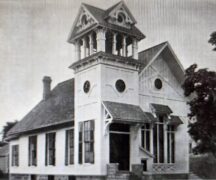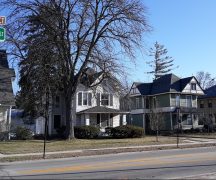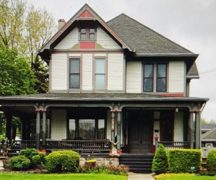By JAN McLAUGHLIN
BG Independent News
The Bowling Green Historic Preservation Commission has been trying to pick up its pace – saving blocks of buildings, rather than just one at a time.
But when it came time last week for a vote to create the first two-block historic district in the city, the commission was split. Three members felt the matter had undergone ample discussion and now was the chance to preserve a city street rich with history.
Two members abstained, voicing concerns that the issue deserved more discussion, and perhaps more individual historical preservation efforts should be tested in the city before standards are set for neighborhoods.
Voting in favor of deeming North Maple Street a historic district were John Sampen, Geoff Howes and Wil Roudebush. Abstaining were Heidi Reger and Christina Tracy. The issue will now go to City Council to decide if the street should become a designated historic area.
So far, historic property distinctions have been declared for one home on East Court Street, the Wood County Courthouse, the BG Police Station, Needle Hall at City Park, and University Hall at BGSU.
About two years ago, in an effort to have a more sweeping impact to preserve historic structures in the city, the commission decided to create historic districts rather than one house at a time. North Maple Street was identified as a good place to start.
The two blocks qualify since all the homes are at least 50 years old, they possess historic significance, they can be identified with a person who influenced society, they embody a distinctive characteristic of an architectural type, and they are a visual feature of the neighborhood.
There are 22 homes in the two blocks running north from West Wooster Street to Conneaut Avenue, with most of them built in the late 1880s or early 1900s.
Most of the houses can be classified as Folk Victorian design. At least one house represents the Eastlake Movement of Queen Anne Style, and one is suggestive of a Colonial Revival building.
“Overall, North Maple Street represents a typical Bowling Green residential area of the early 20th century during a time when the city was experiencing great expansion and population growth,” said Sampen, who lives in one of the North Maple blocks.
“There’s a lot of pride” in the neighborhood, he said.
Sampen reported on a survey of homeowners conducted in March, noting that 60% of the respondents express support for the formation of the historic district.
But Will Airhart, a new homeowner on North Maple, pointed out that not all the residents responded – with just 10 out of the 22 property owners voicing support.
Airhart stressed that he respects the work of the commission, and sees the value of preserving historic neighborhoods like North Maple Street.
“It’s my favorite street in Bowling Green,” he said. “I really appreciate all the work you’ve done to date.”
But Airhart suggested it’s too soon to create a multiple property district, since the detailed information to answer homeowner questions is just not there yet.
“All the building blocks are there,” he said, but more guidance is needed for homeowners.
As a new homeowner, Airhart said he has questions about replacing his front porch swing, installing new gutters, and investing in porch improvements. But information is lacking on what type of changes are acceptable, he said.
“I think this will work really well,” Airhart said. “But take a little bit more time” to gather details.
Sampen said the commission’s goal is to provide reasonable guidelines for homeowners.
“We’re not trying to preserve every brick and board on a home,” but to preserve the overall look, Sampen said.
“I think it’s exciting to have North Maple be the start,” he said.
Sampen pushed back at the idea of delaying the historic designation that has been the focus of several meetings.
“What will happen in 10 years?” he questioned.
But Reger suggested a delay would not have dire consequences.
“It’s survived this long and people have taken care of it,” she said of the neighborhood. Reger said she understood Airhart’s reluctance, and voiced her concerns about government telling homeowners what they can and cannot do.
Sampen addressed a home on West Wooster Street that was neglected for years, with overgrown landscaping and unpainted surfaces.
“This gives some muscle to say – you have to take care of your property,” he said of the designation.
But Reger pointed out that while it took years of orders from the city, the home’s exterior was eventually cleaned up.
Tracy shared hesitation about creating the district, suggesting the commission collect more information from individual homes declared as historic, so a full list of “FAQs” could be established to make prospective historic district property owners more comfortable.
Howes offered that the creation of a two-block district would help provide a “robust set of examples.”
And Sampen asked, what still needed to be discussed.
“It’s not like we just started thinking about it three months ago,” he said.
Bowling Green Planning Director Heather Sayler explained that the ordinance is intended to be flexible.
“It’s to help people make good decisions,” she said.
Rather than creating long lists of specific recommendations, the commission agreed to use guidelines recommended by the Secretary of Interior for the treatment of historic properties.
The goal of historic preservation is to protect the historic integrity of buildings – and help when possible with restorations. It is not to nitpick and tell homeowners what they can and cannot do with their properties.
Three sites and two historic districts in Bowling Green are currently listed on the National Register of Historic Places by the Secretary of the Interior upon recommendation of the Ohio Historic Preservation Office. However, placement on the National Register provides no protection to any historic property.
To fully function, the city became a Certified Local Government through the Ohio Historic Preservation Office. The CLG status allows the city to get preservation grants and tax credits to help homeowners and businesses protect historic buildings.





